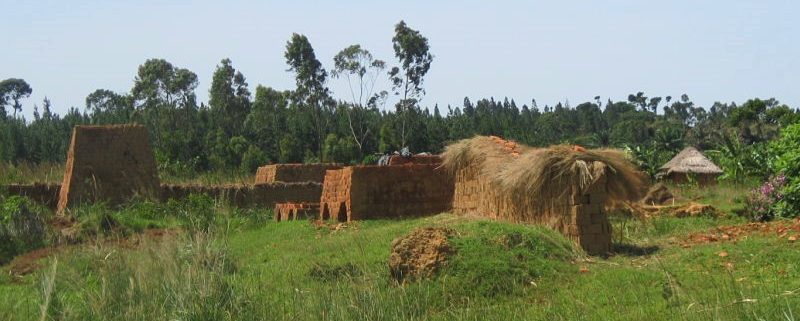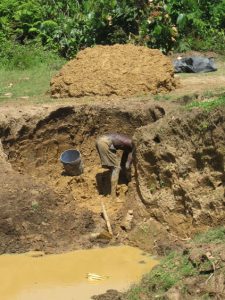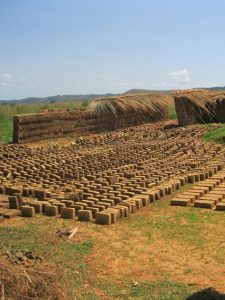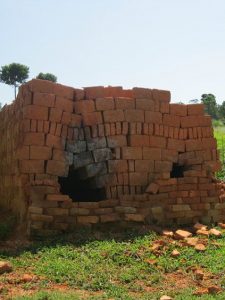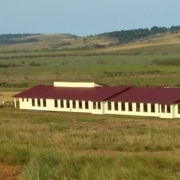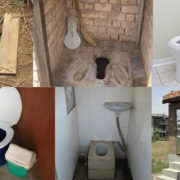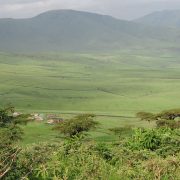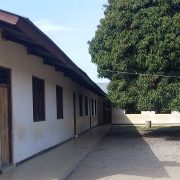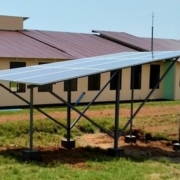Building Blocks
Our September trip provided the information that we needed to make a final decision about the kind of blocks to use for building Twegashe School.
Traditional brick-making
In this part of Tanzania, most village homes are built with bricks made from local soil which is high in clay content. One technique is to simply dry the bricks in the sun and then use them directly for building, generally with mud as mortar. However, these sun-dried bricks break easily, so if a family has sufficient means, they will use kiln-fired bricks instead.
Bushasha actually has a brick “factory” where these fired bricks are made. This “factory” is located on national government land, at a lowland spot where the soil contains a lot of clay. Individual village brick-makers rent space here, and sell the bricks they make for home-construction projects in the village. The bricks are formed in a mold, dried in the sun, and then stacked in the shape of a kiln, with a hollow left inside for inserting firewood.
As this description suggests, there is no actual “kiln.” Instead, the bricks themselves form the kiln for their own firing. Predictably, the results are not particularly uniform—bricks on the inside are subjected to much higher temperatures than those on the outside. Still, the product is reasonably strong and suffices for most village structures, with either mud or cement used as mortar.
One drawback with this production method is that it requires large amounts of firewood. Because wood supplies in the village have become so limited, Bushasha brick-makers are now forced to purchase firewood from outside the village to fuel their kilns.
Compressed stabilized earth blocks
In considering what material to use to build Twegashe School, we had planned from the very start to avoid using fired bricks, in keeping with our aim to make the school as “green” as possible. Our search for something better led us to compressed stabilized earth blocks (CSEBs), also referred to as stabilized soil blocks (SSBs). These blocks use ordinary soil, stabilized with a small amount of cement (4-8%) and then compacted in a press, which can be either manual, diesel-powered, or electric. We discovered a company in Kenya called Makiga Engineering that makes a manual press, and we began making plans to employ the Makiga press for our project.
However, concerns about seismic activity in the region intervened. In 2016 there was a magnitude 5.7 earthquake centered only about 40 miles from Bushasha. The quake caused quite a bit of damage to homes in the village. Earthquakes are not common in this area, but the fact that this quake had occurred meant we wanted to design our buildings to be earthquake resistant, perhaps to a greater degree than was required by Tanzanian building codes. We learned through discussions with our construction design team that the best way to provide seismic reinforcement is to insert rebar into the walls, but this requires hollow blocks. Unfortunately, the Makiga press does not have the capability to make hollow blocks.
A new search led us to a company in India called Aureka that specializes in machinery for sustainable construction. They make a manual press, the Auram 3000, with a wide variety of molds. Several of these molds are designed to make hollow blocks which are rated as suitable for construction in seismic zones. This seemed to be the solution we needed.
Soil suitability
Before making a decision about whether to purchase the Auram press, we needed to determine whether the soil on our site is suitable for making CSEBs. A fairly wide variety of soils can be used but the ideal soil is one that is made up of 80% sand, 10% silt, and 10% clay. The qualitative assessment of the soil we made on our previous trip left us feeling quite hopeful, since the soil appeared to be fairly sandy. But we needed to know for sure.
Over the past year or so we’d been in correspondence with an organization called Good Earth Technology (Tanzania) that promotes the use of CSEBs. They shared quite a lot of information with us, and had also mentioned that they provide a soil testing service. By good fortune, they have a representative in the Bukoba area, Josue Joseph, who has the required equipment for soil testing. He offered to come to Bushasha, collect a sample of our soil, and return it to his facility for testing. The only charge to us would be the cost of his transportation.
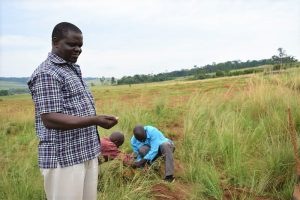
Josue Joseph making a quick qualitative assessment of the soil on our site.
Of course we accepted this offer, and Josue met us at the school site two days after we arrived in the village. At first he expressed some concern that the soil actually might not contain enough clay, and our hearts sank a bit. But after digging down the required meter or so to reach soil free of organic matter, Josue seemed somewhat more optimistic. He left with several cubic feet of soil, and said he would be in touch.
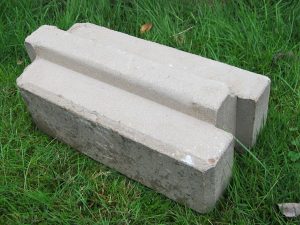 Josue contacted us two weeks later with the good news that our soil worked well for making CSEBs. He even met us in town to give us the sample blocks he had made with our soil. They looked great, and Bill said they passed the fingernail scratch test! The press Josue used to make our sample blocks is the Makiga press, so the shape is different from the blocks we’ll be making to build the school, but the composition is the same.
Josue contacted us two weeks later with the good news that our soil worked well for making CSEBs. He even met us in town to give us the sample blocks he had made with our soil. They looked great, and Bill said they passed the fingernail scratch test! The press Josue used to make our sample blocks is the Makiga press, so the shape is different from the blocks we’ll be making to build the school, but the composition is the same.
We estimate that we’ll need something like 60,000 blocks to construct the school buildings. The technical specifications indicate that the Auram press can produce about 500 blocks per day, so that’s four months straight of block-making! Our plan is to train a crew of villagers for this task in order to create local employment. When school construction is complete, we’ll help this crew set up some sort of cooperative business making earth-friendly building blocks for the village.

